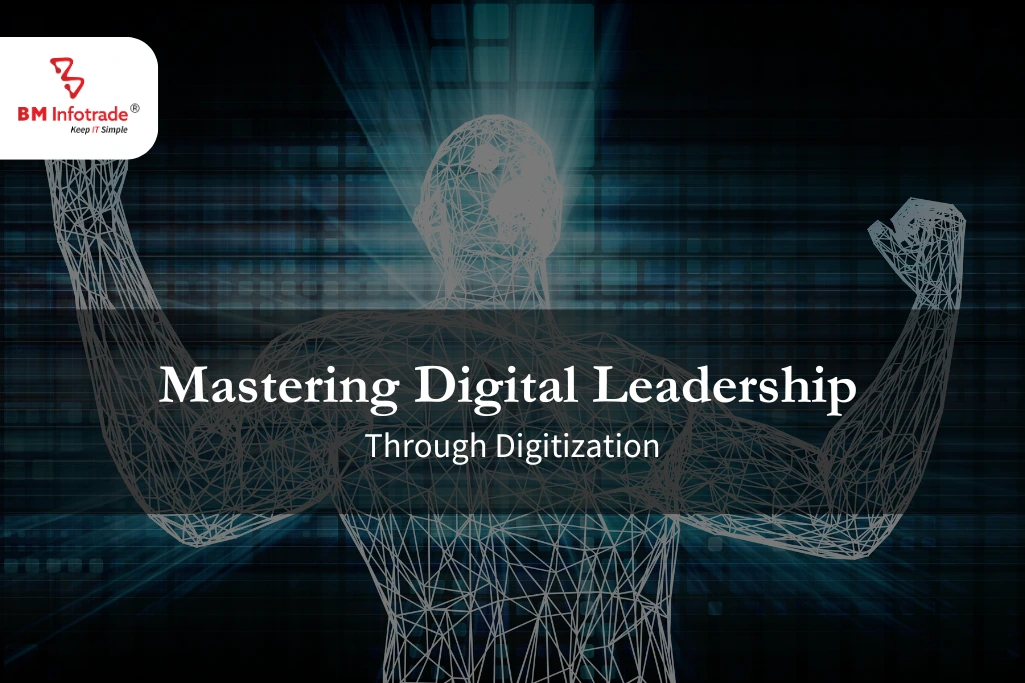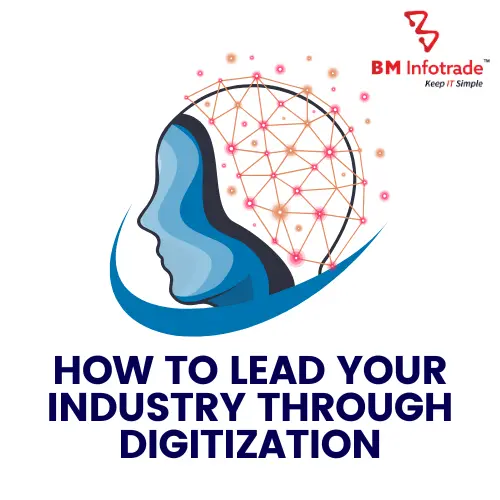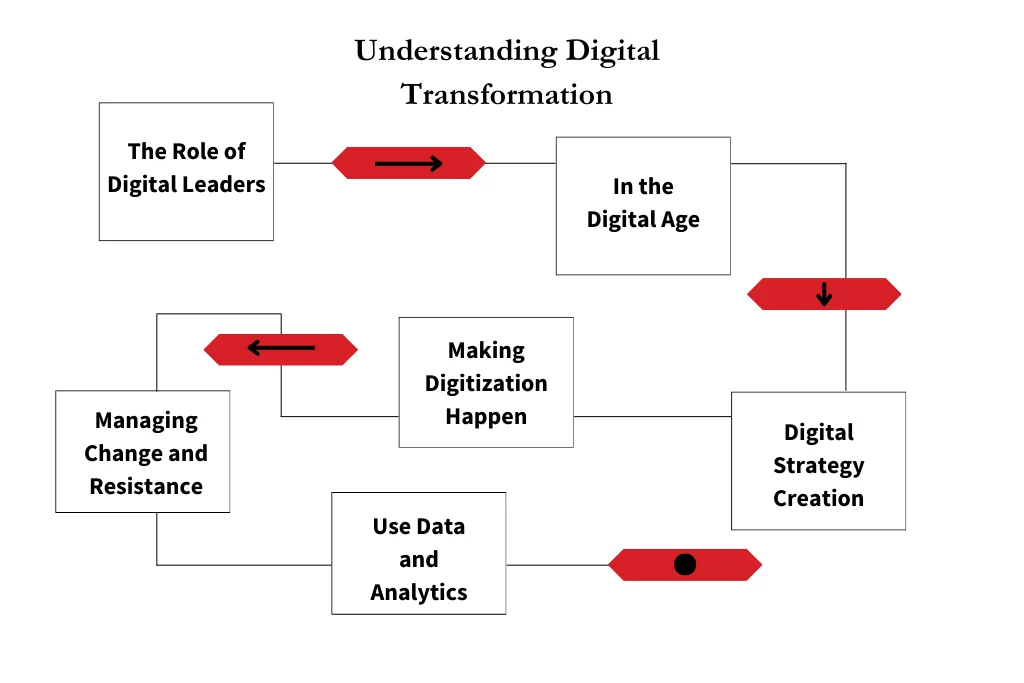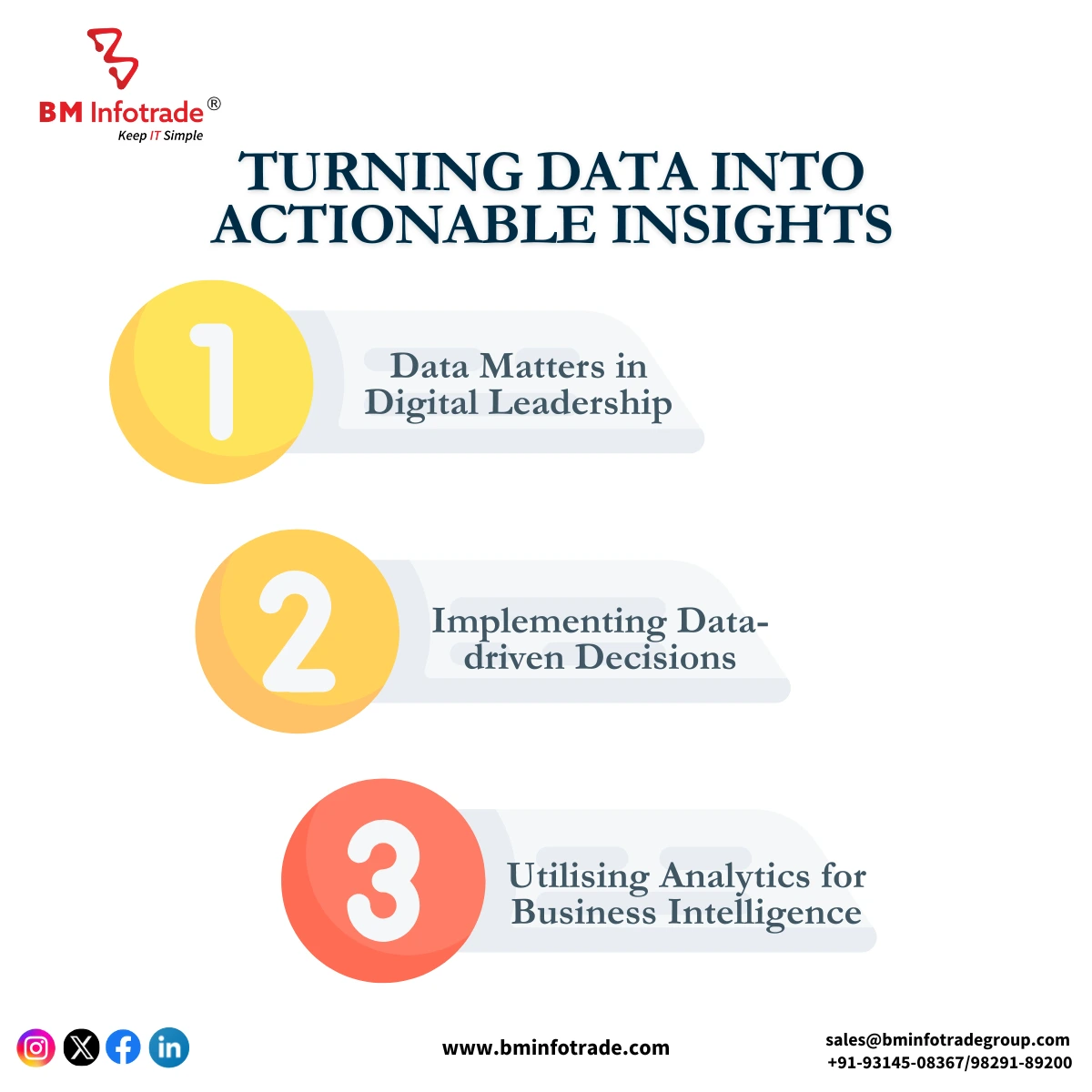Mastering Digital Leadership: Through Digitization
Learn the essentials of digital leadership and how digitization can transform your organization. Explore strategies to drive innovation and enhance performance.

Mastering Digital Leadership: Through Digitization
Table of Contents
- Overview of the Mastering Digital Leadership Approach: How to Lead Your Industry through Digitization
- Understanding Digital Transformation
- The Role of Digital Leaders
- In the Digital Age
- Digital Strategy Creation
- Bringing Digitization to Life
- Leading Digital Transformation Teams
- Managing Change and Resistance
- Digital Transformation Resistance
- Turning Data into Actionable Insights
- Navigating Cybersecurity & Digital Ethics
- Conclusion
Digital Leadership Definition: Leadership has changed in today's fast-changing digital world. Digital leadership is the capacity to use digital technology to innovate, develop, and expand an organisation. To embrace digitization, you must grasp technology and lead cultural and organisational transformation.
Industry Digitization Importance: Industry digitalization is essential in current business. Digitization provides organisations several ways to stay competitive and relevant, from improving operational efficiency to allowing new business models. In the digital age, it's essential for survival and success.
Overview of the Mastering Digital Leadership Approach: How to Lead Your Industry through Digitization
This thorough guide will cover digital leadership and digitising your sector. Understanding the ideas, methods, and best practices in this guide will help you confidently navigate the digital world and lead your organisation to sustainable digital transformation. The following parts will cover fundamental concepts, tools, and approaches for digital leadership in today's changing corporate world.

Read More:- Why digitization is important? "Move ahead with digital power!"
Understanding Digital Transformation
Define Digital Transformation: Digital transformation involves integrating digital technology into all elements of a business to change how it operates, delivers value to consumers, and engages with stakeholders. It uses AI, cloud computing, data analytics, and IoT to innovate, improve efficiency, and generate new income.
Key Digital Transformation Drivers
Evolving consumer tastes and needs require organisations to use digital channels for seamless interactions and personalised experiences.
Fast-paced technological advances provide companies with new instruments to innovate and evolve.
Digitally-native startups disrupt established sectors, forcing incumbents to adapt and alter to stay relevant.
Data privacy requirements force organisations to digitise their operations to comply and reduce risks.
Digital Transformation's Effect on Industries
Digitization simplifies operations, minimises human labour, and optimises resource utilisation, improving operational efficiency and cost savings.
Digital transformation allows companies to provide personalised, multichannel experiences that meet consumer expectations, boosting loyalty and satisfaction.
Digital technology allows companies to reinvent their business models, providing new income streams and disrupting value chains.
Digitalization provides massive volumes of data that organisations may use to get meaningful insights, make strategic decisions, and grow.
Digital leaders must understand the drivers and effects of digital transformation to traverse the digital world and lead their organisations through digitalization.
The Role of Digital Leaders
Effective Digital Leader Qualities:
Great digital leaders drive change and creativity with a clear vision of the future.
Digital leaders adapt to changing digital landscapes and new possibilities and challenges.
They may integrate digital projects with organisational goals to ensure commercial results from digital transformation.
Digital leaders break down silos and unite departments and stakeholders to achieve digital goals.
They encourage teams to experiment, take measured risks, and learn from mistakes, encouraging innovation and continual progress.
Required Skills and Competencies:
Digital leaders comprehend digital technology, trends, and business strategy.
They can drive organisational change and overcome digital transformation opposition using change management methods.
They use data and analytics to make decisions, expand businesses, and gain actionable insights.
Digital leaders are skilled at telling a compelling story about digital change, engaging with varied stakeholders, and gaining support for digital projects.
They may identify and mitigate digital transformation risks, including cybersecurity, regulatory compliance, and technology adoption.
Building Digital Leadership Mindset
Digital leaders demonstrate the values and behaviours they demand from their teams, encouraging digital adoption and transformation.
They encourage teams to accept change, gain new skills, and adapt to new technology by fostering continual learning and experimentation.
Digital leaders encourage teams to experiment with new ideas, technology, and problem-solving methods.
They reward people and teams for digital innovation and change, encouraging desired behaviours and outcomes.

In the Digital Age
Digital Ecosystem Overview
Digital executives must understand how organisations use websites, mobile apps, social media, and email marketing to reach customers.
Study AI, blockchain, AR, and IoT's effects on industrial dynamics and business operations.
Digital leaders need strategic partnerships with technology providers, startups, industry consortiums, and academic institutions to acquire cutting-edge ideas and capabilities.
To comply and reduce risks, they need to understand data privacy, cybersecurity, and industry-specific compliance regulations.
Industry Digital Trends Identification
Digital leaders use market trends, competitive dynamics, and new possibilities to develop and implement digital strategies.
To build personalised, customer-centric digital experiences, they employ consumer insights and market research to understand customer demands, preferences, and habits.
Digital leaders evaluate industry technology adoption patterns to determine how emerging technologies may affect company models, operations, and customer interactions.
They identify gaps and capitalise on competitive advantages by comparing rivals' digital plans, capabilities, and performance to industry best practices.
Competitive Digital Landscape Assessment
Digital leaders benchmark their organization's digital capabilities and performance against industry peers and digital leaders in other sectors to identify strengths, weaknesses, and improvement opportunities.
They assess internal and external factors impacting digital competitiveness for strategic decision-making and resource allocation.
Digital Leaders examine their organization's digital maturity across strategy, culture, processes, technology, and people to identify areas for improvement and prioritise digital transformation initiatives.
Competitive analysis and digital maturity evaluation inform strategic investments and resource allocation by revealing their organization's distinct value proposition, differentiation strategy, and digital marketplace positioning.
For informed strategy and execution, digital leaders must understand digital ecosystems, trends, and competition.
Read More:- Digitization- The Digital Way of Life.
Digital Strategy Creation
Creating Digital Leadership Vision:
Digital leaders outline the organization's digital leadership goals and strategic objectives in a compelling vision statement.
They integrate the digital vision with business goals to show how digital transformation may support key business targets and promote sustainable development.
Digital leaders collaborate with senior leadership, workers, customers, and partners to co-create and promote the digital vision, creating alignment and commitment.
Clear Objectives and Goals
Digital leaders set SMART objectives that match with the digital vision and strategic priorities to guide and hold digital efforts accountable.
They use KPIs to measure digital goals, including customer engagement, operational efficiency, revenue growth, and competitive difference.
Digital leaders constantly assess and refine digital goals and KPIs based on company needs, market trends, and technology.
Matching Digital Strategy to Business Goals
Digital leaders map corporate processes to find ways to digitise, automate, and optimise them, simplifying workflows and enhancing efficiency.
They map the end-to-end customer journey to discover pain areas, friction points, and chances to improve the customer experience using digital touchpoints, personalisation, and omni-channel interaction.
Based on business effect, resource availability, and technological feasibility, digital leaders prioritise digital initiatives, investments, and capabilities to meet strategic goals.
A strong digital strategy requires a clear vision for digital leadership, SMART goals linked with business goals, and a roadmap that prioritises digital efforts to achieve sustainable development and competitive advantage.
Bringing Digitization to Life
Implementation roadmap development
Digital leaders prioritise digitalization initiatives by strategic goals, commercial impact, and feasibility.
They break down large digitalization projects into manageable milestones to avoid risks and ensure progress.
Allocating funds, people, and technology to digitization projects requires digital leaders to reconcile short-term needs with long-term ambitions.
Scrum or Kanban for iterative development, rapid prototyping, and continuous improvement to meet changing demands and market dynamics.
Overcoming Execution Issues
To combat change resistance, digital leaders encourage transparency, communication, and collaboration, include stakeholders in decision-making, and resolve difficulties promptly.
Training, mentorship, and learning programmes equip employees for the digital age.
Digital leaders use incentives and goals to motivate frontline, middle, and senior executives to support digitization efforts.
They detect and mitigate digitization risks such technical issues, cybersecurity threats, and regulatory compliance issues to limit project disruptions and ensure success.
Leveraging Tech for Success
Digital executives evaluate vendor reputation, product roadmap, and TCO to select technology solutions that suit organisational needs, scalability, and integration.
They combine digital systems and data sources via APIs, middleware, and data management platforms for real-time data exchange, interoperability, and analytics-driven decision-making.
Digital leaders utilise user testing and feedback to enhance user interfaces and processes to make digital solutions intuitive, user-friendly, and client-specific.
They track progress, identify bottlenecks, and improve digitalization using analytics dashboards and reports.
Digitization requires careful planning, outstanding execution, and proactive challenge management to succeed and produce value for the company. Technologies and expertise are needed.
Leading Digital Transformation Teams
Cross-functional Team Formation and Management:
- Digital leaders create cross-functional teams with varied skills, backgrounds, and views to stimulate creativity, innovation, and cooperation.
- They set team members' roles and duties to ensure accountability and alignment with project goals and deliverables.
- Digital leaders encourage active listening, feedback, and knowledge sharing to improve information flow and decision-making.
- They encourage teams to take charge of their work, make independent decisions, and try new things, creating project ownership and accountability.
Promoting Innovation Culture
- Digital leaders foster a safe space for teams to try new technologies, methods, and business models to innovate and develop.
- They engage in continual learning and development to provide team members with the skills, knowledge, and tools to innovate and adapt to changing market conditions and technology.
- Digital leaders celebrate experimentation and learn from errors.
- They encourage digital greatness by recognising and rewarding people and teams for innovation, creativity, and problem-solving.
Digital Talent Development in the Organisation
- Digital leaders use employer branding, talent networks, and digital workforce-specific recruitment techniques to attract top people.
- Training programmes, workshops, certifications, and mentoring programmes help employees learn new skills and keep up with developing technology and industry trends.
- Digital leaders provide clear career tracks and development possibilities for digital talent, allowing for growth, progression, and specialisation inside the organisation.
- They promote variety in digital teams since varied viewpoints, backgrounds, and experiences boost innovation and creativity.
- Digital transformation teams need strong leadership, communication, and teamwork skills and a dedication to innovation and digital talent development.
Managing Change and Resistance
Digitalization: Changing Dynamics
- Digital leaders assess the impact of digitization on processes, systems, roles, and culture to identify resistance and disruption.
- They identify change implementation gaps by analysing leadership support, workforce engagement, corporate culture, and change management capabilities.
- Digital leaders identify workers, consumers, suppliers, and partners affected by digitization initiatives and know their needs, concerns, and expectations to tailor change strategies and communication.
- They use stakeholder participation, communication, and risk management to plan, implement, and maintain change programmes.
Digital Transformation Resistance
- Digital leaders publicly explain the rationale, vision, and benefits of digital transformation initiatives to stakeholders and solicit feedback to build trust, buy-in, and support.
- They recruit influential leaders and advocates to drive digital transformation and change momentum.
- Digital leaders help employees adapt to digital transition, decreasing anxiety and uncertainty.
- The organisation aggressively addresses digital transformation concerns, correcting myths and reassuring staff of its commitment to assisting them through change.
Effective Change Communication
- Digital leaders convey the purpose, objectives, and expected outcomes of digital transformation initiatives to stakeholders through several media.
- They encourage leaders and employees to share ideas and make choices.
- Digital leaders consider workers' concerns and empower them to speak out, voice their needs, and engage in change.
- They honour individuals and teams for their resilience, agility, and change-driven digital transformation initiatives.
- To manage change and overcome resistance, digital transformation involves proactive leadership, strategic communication, and stakeholder participation.
Turning Data into Actionable Insights

Data Matters in Digital Leadership
- Data fuels informed decision-making, innovation, and competitive advantage in the digital era, according to digital leaders.
- Data-driven insights into consumer behaviour, market trends, and operational performance inspire strategic decisions and corporate success.
- Data-driven personalisation and customisation: Digital leaders produce information, offers, and suggestions that match consumer preferences and requirements.
- They use advanced analytics and machine learning algorithms to forecast future trends, behaviours, and outcomes for proactive risk management and decision-making.
Implementing Data-driven Decisions
Digital leaders create robust data governance frameworks that define policies, standards, and processes for data collection, storage, quality assurance, and access control to ensure data integrity, privacy, and security.
They use scalable and agile data warehouses, data lakes, and cloud-based analytics platforms to integrate, store, and analyse large amounts of structured and unstructured data.
Digital leaders use business intelligence dashboards, data visualisation software, and predictive analytics models to gain insights, find patterns, and make data-driven decisions.
Utilising Analytics for Business Intelligence
Digital leaders segment audiences, identify behavioural patterns, and find customer acquisition, retention, and upsell opportunities.
They optimise business processes, resource allocation, and operational efficiency to reduce costs and boost productivity.
Digital leaders use market data and competitive intelligence to identify market trends, benchmark against industry peers, and capitalise on emerging opportunities to gain a competitive edge.
They use analytics dashboards and scorecards to measure digital initiatives' impact, identify areas for improvement, and optimise continuously.
Digital leaders use data and analytics to gain actionable insights, drive data-driven decision-making, and unlock value across the organisation, boosting innovation, efficiency, and competitiveness.
Navigating Cybersecurity & Digital Ethics
Digital Security:
Digital leaders conduct comprehensive risk assessments to identify cybersecurity threats and vulnerabilities across the organization's digital ecosystem, including infrastructure, applications, data, and devices.
They use the NIST Cybersecurity Framework or ISO 27001 to create policies, procedures, and controls to manage cybersecurity risks.
Digital leaders use intrusion detection systems, security analytics, and incident response protocols to detect and mitigate cybersecurity threats in real-time.
They educate employees about cybersecurity risks, best practices, and compliance requirements to reduce human errors and security incidents.
Integrating Digitization Ethics
Digital leaders create and follow ethical frameworks and guidelines for responsible use of digital technologies, data, and algorithms to ensure transparency, fairness, and accountability in decision-making.
They protect sensitive data and respect privacy rights with strong privacy policies, consent mechanisms, and data anonymization.
Digital leaders mitigate biases in algorithms and decision-making processes by conducting bias assessments, diversity audits, and fairness checks to ensure equitable outcomes and minimize unintended consequences.
They evaluate the social and ethical impacts of digitization initiatives, such as job displacement, inequality, and digital divide, and address them through stakeholder engagement, community outreach, and corporate social responsibility.
Regulatory and Compliance Considerations
Digital leaders develop controls, procedures, and protections to comply with GDPR, CCPA, HIPAA, and PCI DSS.
They work with legal counsel and compliance teams to analyse risks and execute timely compliance procedures when regulatory landscapes and legal requirements change that affect digital operations.
Digital leaders develop sophisticated data governance frameworks to manage data collection, usage, and sharing in line with legal standards, assuring data integrity, privacy, and security across the data lifecycle.
They establish and manage incident response strategies and processes to quickly and efficiently resolve cybersecurity events, data breaches, and compliance violations, minimising legal and reputational threats to the organisation.
Digital leaders must ensure cybersecurity and ethics in digitalization to generate trust, manage risks, and promote responsible innovation.
Read More: How cyber security works and the cost of cyber security.
Conclusion
In conclusion, digital leadership is essential for digitizing industries. This thorough guide covers digital leadership basics, including understanding digital transformation, defining a digital strategy, and managing digital transformation teams. We've also covered digital landscape navigation, data and analytics, cybersecurity, and digital ethics.
Organizations may learn how to sustain development and innovation in the digital era by studying successful digital leaders and predicting future trends. Digital leaders must be imaginative, strategic, and ever-learning.
Organizations must emphasize stakeholder involvement, stimulate innovation, and use agile methods to overcome difficulties and grasp opportunities in the changing digital world as they evolve. In a digital age, companies may succeed by adopting digital leadership strategies.





![Cloud Licensing and Compliance Made Easy [All-in-One Bundle]](https://bminfotrade.com/assets/upload/blog/21851766642757.png)

Anshul Goyal
Group BDM at B M Infotrade | 11+ years Experience | Business Consultancy | Providing solutions in Cyber Security, Data Analytics, Cloud Computing, Digitization, Data and AI | IT Sales Leader